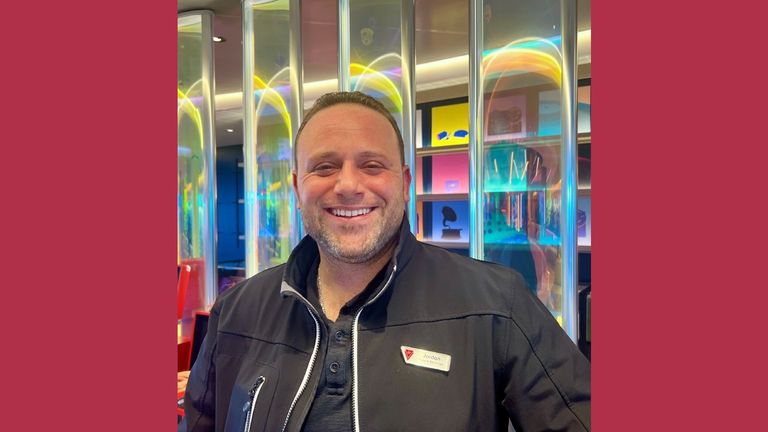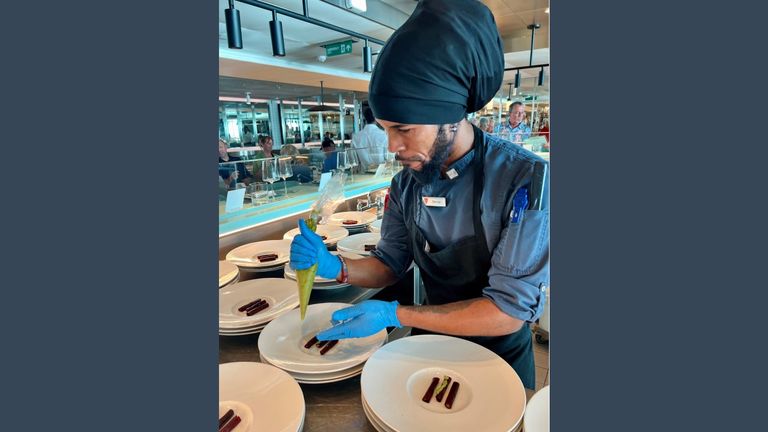Jordan Bernstein joined Virgin Voyages in February 2018, coming onboard the team at the conceptual stage for Scarlet Lady, the first ship from the brand, which launched in 2020.
Now, the line’s fourth ship, Brilliant Lady is scheduled to arrive in 2025. I sat down with Jordan Bernstein, the director of food and beverage operations for Virgin, to learn more about how the line’s culinary program was developed, and how it has since emerged as one of the brand’s hallmark assets.
 Jordan Bernstein is the director of food and beverage operations for Virgin Voyages.
Jordan Bernstein is the director of food and beverage operations for Virgin Voyages.
Credit: 2024 Virgin Voyages
What was Virgin’s original food and beverage concept, and how has it evolved?
At the point I came in, we had just our master food and beverage strategy. We wanted to be able to offer an experience like you would get in Miami, or London, or New York — smaller restaurants with more intimate settings and shorter menus.
We didn’t want to have one chef create all our menus, because chefs tend to stay in their zone and then things look alike, whether they’re Mexican or American or Asian. We went out to seek partners to make us different.
We wanted to be able to offer an experience like you would get in Miami, or London, or New York — smaller restaurants with more intimate settings and shorter menus.
Shorter menus? That’s going the opposite direction of what some cruise lines have done the last few years.
Originally, we had very short voyages, so we wanted more compressed menus, but [be able] to do those items really, really well.
Now, our chefs in the Galley [a dining hall-style venue with shops and food-truck-style carts] have a bit more freedom to go out and pick up local ingredients. When we’re sailing through Spain, you’ll see a Spanish-style burger up in the burger bar.
You have six full-service restaurants, plus the Galley, which takes the place of the buffet option on most ships. So, on a seven-night cruise, guests have the potential to dine at a different venue each night — all covered in the cruise fare, without a surcharge. But at one restaurant, The Test Kitchen, guests are limited to a fixed, six-course tasting menu?
Originally, The Test Kitchen had one core menu, but when we had longer voyages we wanted our sailors to be able to come back. So, we created a menu that switches after three days, and eventually, we’ll bring in a third menu.
The formula is fairly rigid. As the line has matured, are guests asking for new dining concepts?
You know, there was so much thought and planning behind this product, but we’ve pretty much stuck to our initial guiding principles. I think we’ve done a little bit more to cater with vegetarian, vegan and gluten free options.
I think we’ve done a little bit more to cater with vegetarian, vegan and gluten free options.
More people are going towards cleaner, healthier, vegetarian lifestyles, and more than 20% of people have food allergens and intolerances. We wanted to make sure that we were offering that and not just saying, “Here’s a plate of vegetables.” We wanted to get that right, right off the bat.
 Devroy Willis, a member of Virgin Voyages’ culinary team, helps prepare an onboard dish
Devroy Willis, a member of Virgin Voyages’ culinary team, helps prepare an onboard dish
Credit: 2024 Virgin VoyagesMy recollection is that the restaurant Razzle Dazzle was originally set up as a vegetarian venue, right?
It was always meant to be like an American diner, but veggie forward. We want people to try everything, but also, we need to evenly distribute sailors to provide great service. We can’t have one restaurant with 50 people and one with 400, and we heard people saying, “Oh, I don’t want a vegan restaurant.”
So, we went from veggie forward to more like a new-American style. We started to offer the secret menu, which was a steak, then butter chicken, and now we have a burger.
Are there particular restaurants that guests should book in advance?
Our most popular restaurants are the ones that are the most comfortable and approachable. In every city, you always have an Italian restaurant, and you always find a steakhouse or seafood restaurant. So, our Italian restaurant, Extra Virgin, and The Wake, our steakhouse, are the most popular. If you’re looking to come onboard and celebrate something special, I would say to make a reservation.
In addition to not adding fees for specialty restaurants, there’s no added gratuity for cabin staff, or for drinks. But are Virgin’s bar crew and wait staff compensated comparably to how they would be on other cruise lines?
On other cruise lines, you get nickel and dimed. We take care of our crew with a set monthly salary — comparable to what they would make with other lines, but a lot more consistent. Our teams are happy with that, so all they have to worry about is serving our sailors.
On other cruise lines, you get nickel and dimed. We take care of our crew with a set monthly salary.
I also love the diversity of the crew here, both in terms of heritage but also in other ways, and that feeds into the diversity of your guests.
You always have a high percentage of Indian, Filipino and Indonesian crew, but we’ve partnered with other hiring agencies around the world to make sure we keep a gender and nationality balance.
If you look at our sanitation department — the dishwashers, the ones cleaning the crew areas, the front-of-house — it’s more than 50% female, something you never see on any other cruise line. And once they get promoted, they’re going into housekeeping or to work in the restaurants or in the bars.
So, our recruiting strategy is to have a high number of Eastern Europeans, Western Europeans, South Americans and of course, Asian [individuals]. We’ve done a pretty good job with that. I think one of the things we’re most proud of is having such a diverse crew, and a high female-to-male ratio, as well.